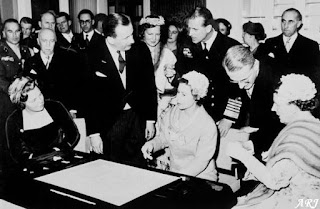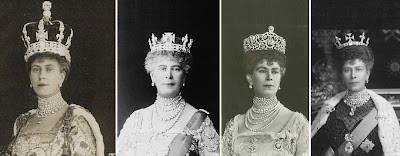 |
| Cullinans III and IV Brooch (Granny's Chips) |
The remaining numbered stones (Cullinans III, IV, V, VII, VIII and IX), along with 96 smaller stones remains with the Asscher as a commission. In 1910, the South African Government acquired the stones and presented them to Queen Mary.
 |
| Queen Mary's Crown and its detachable Coronet set with Cullinans III and IV |
After the coronation, these stones were replaced with quartz crystal replicas so that the jewels could be used in alternative settings. The Koh-i-Noor was later used for the Crown of Queen Elizabeth (The Queen Mother), while Cullinan III and IV were set as a brooch.
I and II worn as a brooch.
Nevertheless, the two diamonds were most often worn hooked together as a pendant brooch. Queen Mary loved this brooch (her “chips”, as she referred to them) for important events of official portraits. Probably one of the most memorable occasions Mary wore the brooch to was the wedding of Princess Elizabeth and the Duke of Edinburgh in 1947.
 |
| Queen Elizabeth wearing "Granny's Chips" throughout her reign |
The first time Elizabeth II wore Cullinans III and IV Brooch was for a visit to the Asscher Company in 1958, during a state visit to the Netherlands. Joseph Asscher – the man who was tasked with cutting the Cullinan diamond – was already dead by the time of Queen Elizabeth’s visit; however, his younger brother, Louis Asscher (who had also been present during the cutting of the original Cullinan stone) was there. The Queen unpinned the brooch and handed it to him for a closer inspection; the elderly man, nearly blind by the time, was deeply moved by Queen Elizabeth's thoughtfulness. That's also when Queen Elizabeth was heard referring to the stones as “Granny’s Chips” – a name it is now most commonly known under.
 |
| Queen Elizabeth during a visit to the Royal Asscher's in Amsterdam |
To read more about the fascinating story of the uncut diamond, have a look at this article - Day in History: The world’s largest diamond ever, the Cullinan, is found.
Sources and photo credits: Royal Collection, “Diamond: A Journey to the Heart of an Obsession” by Matthew Hart, “The Queen’s Diamonds” by Hugh Roberts, "The Queen's Jewels" by Leslie Field
Sources and photo credits: Royal Collection, “Diamond: A Journey to the Heart of an Obsession” by Matthew Hart, “The Queen’s Diamonds” by Hugh Roberts, "The Queen's Jewels" by Leslie Field


No comments:
Post a Comment